Three Methods You Can Use to Create Photos Instead of Capture Them
Stop simply capturing images and start creating them; this is how you’ll put your unique stamp on your photos.
Everyone always talks about capturing images, but not about creating them. We can create in Photoshop, but so too can anyone else. It’s my firm belief that creating in camera is the best way as it means the photographer took all the methods and steps to create a photo organically rather than by compositing, layering, etc. in post-production which makes a photographer a better photo editor than a photographer. Though this idea could be controversial, these methods aren’t in use much because everyone is afraid of them. So, why not try them?
Multiple Exposure Mode
Everyone says multiple exposures are difficult. And yes, they are not easy. Our lead image is a multiple exposure photo as is the one above. What makes them hard is they require a photographer to have a clear creative vision. Once they do, they can go along for the ride with the execution. Like anything else, it takes practice. Many modern cameras have multiple exposure modes built into the camera, we just have to use them. Some even provide previews of what you can expect. By using these previews and reaching deep into our technical and creative side, we can express ourselves more deeply.
Try this: Photograph your day or an environmental portrait using the multiple exposure mode in-camera.
Second Curtain Flash Sync

F8, 1/6th of a second and ISO 250. F8 was used to ensure I’d get that area in focus when Jordana was moving about. 1/6th was used to capture the motion of the hula hoops.
A fast flash duration is what stopped the fast-moving motion, but second curtain flash captured the trail.
The first thing you should know is that tons of photographers are afraid of the flash: yes, even the bigger and more popular photographers. But flash is magical and adds extra sparkle and pizzaz to your images. Certain flash methods, such as second curtain flash, are even better. It allows you to capture light trails while stopping fast-moving action in a scene. It’s what you’re probably used to seeing in many party photos.
Try this: Look for light trails in the streets and photograph someone with frontal lighting. You’ll need a very slow shutter speed.
Stroboscopic Flash
The above image is a single shot with flash. The flash is very specific and direct in order to emphasize a certain area. That’s an effective method to setting a mood, but if you want to do more than just capture what someone is doing with a flash, then try stroboscopic flash.
The stroboscopic method lets the flash quite literally strobe. When it does that, it captures a trail and a number of movements all at once. It is similar in how it lets a photographer do what multiple exposures can do, but in a different way. However, this often requires knowledge of math and, as we all know, math is hard.

Pro Tip: Flashes synced by radio can handle nearly any lighting situation except for stroboscopic shooting. This is when the flash repeats its output a certain amount of times in a given time period. The result is a lot of stopped motion.
We’ve got a fuller tutorial on how to use Stroboscopic flash right here.
Try this: Photograph an athlete or a dancer using stroboscopic flash.


